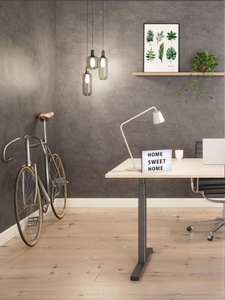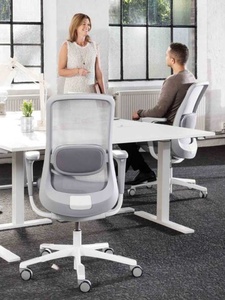We are often asked at KOS Ergonomics what the best office chair is for back pain? Generally the answer comes down to personal preference, but if you are unfortunate enough like many to suffer from chronic back pain there are a specific set of ergonomic features you should look out for when buying your next chair.
Sitting can actually cause lower back pain
Sitting in general isn’t bad, but if you find yourself sitting a lot it can be. Unfortunately, this is the case for many of us. According to a recent study of European participants, 18,5 % of people above 18 years old sit for more than 7.5 hours a day.
The way we sit, especially in working positions, gives us a fixed posture this increases stress in the back, shoulders, arms, back of the neck and legs with the back muscles and spinal discs often receiving an increased amount of pressure. A lot of people that sit this way at home or at work don’t have the right chair to support them meaning the pressure for them is even worse.
What are the benefits of using an ergonomic Chair?
It’s easy to pick up an office chair from any store but what differentiates an ergonomic chair from a normal office chair?
Using a bad chair and without the correct knowledge on how to sit correctly, people can end up in very uncomfortable position, including well know ones like slouching in the chair or bending forward in a banana type shape. Resulting in overstretching of spinal ligaments and strain on discs and surrounding structures of the spine.
If this is left unresolved for a long period of time it can result in long term damage to spinal structures.
Even if you currently don’t suffer from back pain, investing in a suitable chair is a wise choice to help prevent future problem .A three-month study that examined back problems of sedentary and active workers found that desk workers were at a higher risk.
What makes an ideal ergonomic chair?
1. SUPPORTIVE AND ADJUSTABLE BACKREST
An optimal backrest should have a shape that supports the natural curve of the spine, especially in the lumbar region. The lumbar support is crucial for preventing back pain and will take away some of the pressure on your lumbar spine.
The backrest should be adjustable in height and depth, and you should be able to tilt it backwards and forward. The depth has to be enough for you to be able to get good lumbar support while leaving 2-4 inches between the back of the knees and the chair seat.
Low and narrow backrests are good if you have work tasks that require upper-body mobility. This way your arms have enough space to move as they need. Tall and wider backrests are good for reclining, and then they should reach your upper back or neck. But, make sure you still get good lumbar support. There should also be a locking mechanism that secures the backrest from going further back than the user wants it to go.
2. ADJUSTABLE SEAT HEIGHT
The seat height should allow you to sit with your feet flat on the floor and your thighs should be horizontal. Your arms should get an even 90-degree angle with the desk. If this is an investment for your colleagues at work, make sure that the seat height is adjustable enough to fit shorter people as well, or that you buy some footrests to help them sit comfortably.
3. SEAT TILTING POSSIBILITIES
The forward or backward tilt of the seat should be adjustable, to be able to support you through different kinds of tasks.
The below video answers some of the above questions and can help you see the benefits of choosing an ergonomic chair over a normal office chair
Are you looking for a new ergonomic chair to help solve your back pain problems?
If you have any questions or would like us to help you find the best ergonomic chair for you, feel free to contact us at : enquiries@kos.ie
or shop the full range now at https://www.kos.ie/
The video highlights the attributes we should expect from an ergonomic office chair - easily adjustable to fit the user, good support, freedom of movement, varied sitting positions. These are important where sedentary work is contributing to back pain and in the relief of existing back problems.















